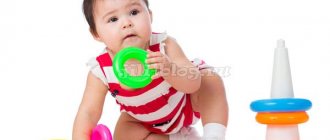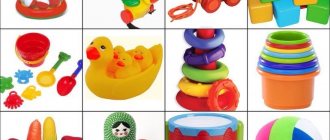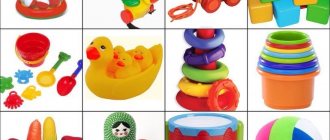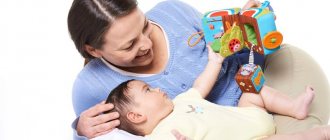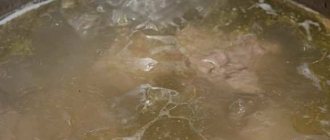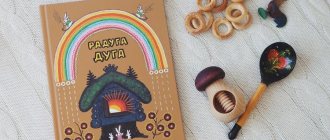As I already said, I absolutely love to systematize everything, and therefore today I will bore you with another plan of educational games and activities. I really hope that this summary will help you navigate the many games with a 1-year-old child, which have already been written about earlier. Personally, without such specific development programs, I feel like I have no hands, because I really want to meet my daughter’s needs for knowledge, impressions, and discoveries that change almost every month.
This comprehensive program has everything for the comprehensive development of a child 1 year - 1 year 3 months: development of motor skills, creativity, exploration of the world around us, and much more.
Detailed plans for other ages can be found here:
READY PROGRAMS FOR DEVELOPMENTAL ACTIVITIES
So, how to develop a child at 1 year old (To read more about each game and its various variations, click on the title link ):
Games and activities to develop sensorimotor skills
What's new at this age:
- We arrange small objects into cells;
- We master instrumental actions (pour sand into a bucket with a scoop, knock with a hammer (play with a knocker), remove toys from water or from containers using a spoon, ladle, etc.);
- We play with the simplest insert frames (with an image of the inserted object in the background);
Example of an insert frame (Ozon, My-shop, Read)
- We play with caps (put them inside each other, make pyramids, compare by size);
Example of caps (Ozon, My-shop, Read). A similar game principle is wooden rainbow.
- We roll the car along roads, hills, with a load;
- We tear paper/cotton wool;
- We play with cereals, sand, water (pour from one container to another, pour using a jug, scoop it into the palm of your hand, “salt” it with sand scooped into a pinch, etc.);
- We learn to push objects (into a piggy bank, into a hole in a box, into a plastic bottle, into a colander, into a sorter);
- We play with an educational lacing toy;
Lacing example (KoroBoom, Labyrinth, My-shop)
- Roll the ball/ball along the slide/grooves;
An example of a bowling alley (Ozon, Labyrinth, My-shop)
- We carry a gurney;
- Peel the boiled egg;
- We tear off the pieces of tape glued to the cube;
- Unwrap items wrapped in foil;
- We learn to unfasten Velcro and zippers;
Examples of toys useful in this matter:
DIY educational mat
Book “I dress myself” (Ozone, Labyrinth, My-shop)
Board with fasteners (My-shop, KoroBoom)
- Transfer the beans from one bowl to another;
- We string small rings onto the pyramid;
Example of pyramids (Ozon, Labyrinth, KoroBoom)
Already familiar games:
- We string/remove rings from the pyramid;
- We put/put out small items from a box or other container;
- Open/close boxes, jars, nesting dolls;
- We stack the cubes on top of each other;
- We play with small objects (take them out of the sensory box, put them in a jar);
- Playing with sensory boxes;
How to spend time usefully
Parents can choose activities at home with a one-year-old child on their own. After all, all children are different, and what is exciting for some is of no interest to others.
In order to entertain the baby at home and engage in its development, parents should give preference to games that:
- Helps develop thinking. During the lesson, it is very important to use toys, cards with images of animals, objects that surround us.
- Have a positive effect on improving physical capabilities. As a rule, these are active entertainments, during which the child can imitate adults or fulfill their requests.
- Associated with instilling a love of creativity. Despite the fact that it won’t be possible to keep your baby busy with such activities at home for a long time, and the result will not always be as expected, you need to do it.
It is important that parents take part in this, because their support is important for the baby.
- Develop speech. Just at one year old, many children begin to utter their first conscious syllables, which soon turn into long-awaited words.
Therefore, not knowing what to do with a one-year-old child, you can consider options for games in which this skill can be developed. For example, you can familiarize your baby with the sounds that animals make and ask them to repeat them.
Based on these recommendations, classes will bring pleasure to the baby, as well as to his parents. After all, it’s a pleasure to watch how a little one, who just recently could only coo, tries and learns – this is true happiness.
Modeling
- Educational games with dough;
- Modeling from plasticine.
Games for the development of children from 2 years old
- Drawing. Let's try to paint the gray bad weather with bright colors! Subjects for drawing are suggested by Yulia Kasparova.
Fun Train. Draw a train on a piece of paper. Now let’s start drawing carriages to the train, and take turns with the baby in the windows to depict passengers. Maybe your whole family is traveling on the train (and don’t forget about your cat, hamster or parrot), or are they characters from your favorite fairy tales and cartoons? The main thing is that they all have fun, and around, in the green meadows, bright flowers bloom and colorful butterflies flutter.
We are building a city. If you have a large sheet of Whatman paper or other white paper, it will become the place where “the city will be founded.” Spread it right on the floor, grab pencils and markers and start “building” your own city with your child. What kind of houses, shops, cars, trees will there be here? Who will live here? Perhaps everything will be the most ordinary and familiar, or vice versa - amazing and fabulous? But in any city, be sure to draw a candy store, a zoo and a circus. What would we do without them? This “drawing” game is also good because you can play it for more than one day. Tired of drawing, we rolled up the paper and put it away. But after a while, the baby’s interest will flare up with renewed vigor. And you can draw not only the city, but also the seabed, space, a bird market, a kindergarten, a prehistoric land with ancient lizards, Africa or Antarctica, in general, everything that excites and interests the little artist at the moment. And on a large sheet of paper and with his mother’s participation, his imagination and artistic abilities will be fully revealed!
Bright window. You can also draw on window glass with regular gouache. This is also a great mood lifter. After all, you can paint a dull day in bright colors and admire your creation from the window...”
Speech development
- We learn finger and gesture games;
- We perform the first aritculation exercises (learning to blow);
- Game “Who lives in the house?”;
- We recite special poems together that encourage the pronunciation of sounds and words;
- We use simple onomatopoeic words in speech (we remember how different animals speak (mu, woof, be, etc.), what sounds like (bell - ding-ding, car - beep, etc.))
Games with children aged 1 year (+/- 2 months). Part 1
I have been wanting to write this article for so long. I finally found the time and wrote. I will write all the information in several stages. In the article, I tried to collect all the games that we tried to play, and our reaction and opinion on them (I’m attaching photos somewhere). In games, I tried to use available tools to the maximum, since I am a supporter of the fact that children do not need a lot of toys, they need attention and the right love. By correct love, I mean that you need to be able to explain to the child at the right moment why you will not do what he wants, etc. Otherwise, your strong love can only harm the child. I will tell you my opinion (this is our experience with my daughter, everything may be different for you) about toys for children: which ones we need, which ones we like, which ones we shouldn’t buy, in another article.
I wanted to immediately note that these games are recommended not only for children 1 year old, but they can also be played by “younger” children, or older ones. The main thing is that the games are fun and evoke positive emotions. The child does not necessarily have to succeed as it is written; all children are individual.
1. Game “What’s in the boxes”
Purpose of the game: The child will begin to understand what empty is. Learn (or practice, if you already know how) how to tear off a box.
What you will need for the game: a box and toys that will come in it.
How to play: It's very simple. You need to put the toys in the box and close it. Next, ask the baby: “What is in the box? Let's watch!". The baby opens the box (or you open it, if the baby doesn’t know how, at the same time he learns this skill). You say: “Well done! Opened the box (or Well done to us! Opened the box!). Oh, what's going on here? Is this a cube? You gradually take everything out of the box, then explain to the child that the box is empty.
Next, you can teach (always playfully) how to fill the box with objects and close it.
2. Game “Shifting the cereals”
Purpose of the game: Development of the child’s motor skills
What you will need to play: 2 containers and some cereal. Better beans or peas (so they are larger).
Attention: At this age, the child continues to explore the world through his mouth. Therefore, watch carefully so that he does not put cereal into his mouth. If a child sucks a pacifier, then you can offer it to him, then the game will be calmer (the child will not have the desire to taste it).
How to play: Pour the cereal into one container and ask your child to transfer the cereal into the empty container. Show yourself first.
Our reaction to this game: We like the game, we try to take the cereal with our fingers and transfer it. True, at the beginning we try to transfer it to an empty container, then we realize that the cereal can be scattered. An interesting game, hopefully useful. True, you need to clean up a little after it. Consider your time for sweeping after the game as well.
3. Game “Drawing with cereals”
Purpose of the game: Development of the child’s motor skills
What you will need to play: a table and semolina. You can also add another cereal a little later (buckwheat, rice, oats, etc.)
Attention: At this age, the child continues to explore the world using his mouth. Therefore, watch carefully so that he does not put cereal into his mouth. If a child sucks a pacifier, then you can offer it to him, then the game will be calmer (the child will not have the desire to taste it).
How to play: Pour cereal onto a children's table and show how you can draw with it, then pour it into a pen and pour it onto the table. You can later add another cereal so that the child has a different sensation.
Another version of this game: pour different cereals into a bag and let the child play with this bag. It’s very good when the grains are multi-colored (for example, buckwheat, semolina, oats, lentils, etc.)
Our reaction to this game: My daughter looks at the cereal with interest and tries to pick it up with her fingers. He studies its properties. She sits serious for about a minute, and then begins to play around, throw her in different directions, smiles (she likes to misbehave)
4. Game "Matryoshka"
Purpose of the game: We teach the child to distinguish between: big and small.
What you will need for the game: a matryoshka doll or several boxes of different sizes, or maybe a pyramid of cups.
How to play: you need to show the baby that there are small objects and larger objects. That a large object can contain a small object. Well, you know best how to do this for your baby.
Our reaction to this game: We have a pyramid of cups (bought at Ikea). We have been trying to play this game since we were 9 months old. Closer to one year, my daughter became interested not only in breaking a pyramid of cups, but also in trying to put one cup into another. It is very interesting to see a child's progress in mastering this skill. I would also like to add that we also use rings (large and small) to study “Big” and “Small”.
By the way. At Ikea, a pyramid of cups costs about 150 rubles. And it's so functional. You can build a pyramid from it, you can put a glass into a glass, you can learn colors. I also play like this: I turn the cups over, put something under one cup, then mix the cups and ask you to find what I was hiding. By doing this, I ensure that the child understands the relationship (where I put it, where I moved it), so that he remembers which glass I put it in (distinguishable by color and volume).
5. Game “Twist, unscrew the lid”
Purpose of the game: Development of fine motor skills. Learn how to unscrew and tighten the lid.
What you need to play: An empty bottle with a screw cap. It is better that the bottle is plastic and the lid is large (so that it does not fit into your mouth). In the photo we have a bottle of regular kvass, but it has a small cap. Then I took a bottle of Alexandrov drinking yogurt, tore off the sticker, washed it and let the baby play. There is a larger lid and it is plastic.
How to play: Show your child how the lid is unscrewed and twisted. Although I think that when you give him a bottle, the child will immediately begin to do it himself, because he has seen you do it many times. For example, with jars of baby food.
Our reaction to this game: We really like this game. If I understand that she wants to work with her hands and brains at the same time, then I give her a bottle to play with and go about her business and watch her from the side. She sits for about 15 minutes and plays. So great!!!
In general, use your imagination and come up with games that suit your child. To understand in which direction it is most interesting for children to play, proceed from the information that children usually know how to play by the age of 1 year and 3 months.
There are a lot of games, fantasize, try, communicate with your child.
The street, or better yet, fresh air (even better, sea air) develops a child very well. Remember yourself, even when you were one year old, but when you were older, did you like to go for walks? I really loved to walk, run, and play with other children. I noticed that my daughter really loves the street. He gets up and as soon as he has the opportunity to get away from me (we have a ritual in the morning with listening to the song “Rise and Sing,” stretches, jokes, etc.), he immediately runs to the street door. I think that the street is freedom, it is closer to the ground. And how many things are useful for development on the street:
- • ¬ Sandbox.
Oooh, we love to play in the sandbox, and especially to taste the sand.
Advice: if your child sucks a pacifier, it is better to give it to him when he is sitting in the sandbox, so there will be less temptation to try the sand. But you still need to watch him carefully, because at any moment the pacifier will be spit out and sand will be tasted.
In the sandbox you can show your child what a scoop and bucket are, how to dig sand, how to pour it into a bucket, how to play with molds and much, much more. The main thing is to introduce sand and objects new to it.
I am attaching a photo of the sandbox we have at our dacha. I painted it. I found time for this (it was from 23:00 to 1:30, I did it in the dark). I wanted something bright and interesting. My husband bought white paint and colors at the store. I cut out circles, squares and triangles from cardboard. The main layer, something like some kind of orange or brown color, we had paint.
- • ¬ Swing.
We also love swings. But I taught her to be sure to hold on when I pump her, and if she lets go, then I stop pumping. My opinion is that it is not worth pumping them high. They won't understand this. And the higher, the more dangerous. The most important thing for them is the process of rocking and communicating with their mother.
Although we didn’t immediately fall in love with the swing once and for all. At first my daughter rocked with joy. And from about 9 months she showed with her head where the swing was. But then she was wedged, and she only approached the swing, touched it, but did not swing. After a year, I began to happily swing for half an hour. This happened after she had to wait for the swing to become free.
- • ¬ Slides and many other things that are on the playground
Slides, stairs, houses, carousels, etc. are good structures for a child’s development. Let him climb with you, while you say that this is what a child does.
In general, I am a supporter of giving reasonable freedom on the street. By this I mean that you cannot constantly walk around in a “safety net” position in case you fall.
Attention, we turned 1 year old on June 14, so I’m writing about the time of year - summer, but if your child is 1 year old in winter, then I’m sure that there are also a lot of interesting things in winter, but you can only walk less, but when your baby is 1 ,5 years, then it will be summer outside.
There are a lot of games, I really wanted to write about everything, but I don’t have much time, so I decided to divide it into parts.
Thank you for developing your child and taking the time to read my experience. If I helped or inspired someone, I’m very happy about it, it means I didn’t spend my time in vain. I hope to continue to inspire and help you! Please write your ideas! I am also inspired by other people on the Internet and my friends. I have a lot of ideas, I want to share with you. I'll try to write more often! I will be glad to meet new people on the Internet.
“It’s fun to walk together…” I remembered the words of the song
I plan to share with you:
1) Our opinion about toys (which ones we like, which ones we don’t pay attention to, etc.)
2) Other parts on the topic “Educational games with children from 1 year to 1 year and 3 months”
3) Our books (with attached photographs of books)
4) Our cards with pictures in English and Russian
...ideas for creating toys, ideas for creating children's albums, and much, much more.
I haven't been able to attach photos yet, I'll try. I'm at the dacha, internet via phone, but I'll definitely do it
Reading books
Collections of books for reading to 1-year-old children can be found here:
BOOKS FOR CHILDREN FROM 1 YEAR OLD. A SELECTION OF THE BEST FAIRY TALES AND POEMS - READ
DEVELOPMENTAL BOOKS FOR CHILDREN FROM 1 YEAR - READ
Games for children from 3 years old
- Magic bag. In a small bag (or pillowcase) put several children's toys that differ greatly in shape, say, a cube, a rubber bear and a pyramid ring. The baby, without looking into the bag, puts his hand into it and determines by touch which of the toys he took. Only after this can you pull out your hand with the toy. Toys can be replaced with vegetables, fruits, and geometric figures.
— Collage . Let's find some old unnecessary magazines or catalogs. Let's cut out the pictures we like and make up a story with them. We will paste the pictures in story order into a thin notebook, and mom will write captions for the pictures in large letters.
— Drawing on paper plates . They can be painted with ornaments or even depict landscapes and still lifes. Why not make a gallery of “plate” portraits? At the same time, you can tell how in past centuries the walls of noble houses were decorated with family portraits. Or introduce your child to the concept of a family tree. Then we place the portraits of the parents under the portraits of the grandparents, brothers and sisters - on the same line, etc.
- Hide and seek . Of course, the mother will have to play along with the children, “not finding” them for some time. And don’t forget to learn the sentence: “One, two, three, four, five! I'm going to look! Ready or not, here I come!"
— Cheerful palm . We place our hand on the paper. Draw along the outline with a pencil. Cut out and paint with colorful patterns. You can depict a face with hair sticking up.
- Rope walker . With arms outstretched to the sides, we walk, like tightrope walkers, along the edge of the carpet, along a jump rope or a bright ribbon stretched out on the floor.
First lessons
- Let's get acquainted with the concepts: big-small, many-little, identical, cold-hot;
- Learning colors;
- We count everything around while communicating with the baby (steps, buttons, toys);
- We study geometric shapes;
- Viewing Doman cards or other educational material that expands your child’s horizons
How to organize walks correctly
The choice of time for a walk depends on the daily routine and does not have strict restrictions.
Some people prefer to go for a walk after completing their morning routine and having breakfast, others choose the time after a nap, and still others go for a walk in the evening. It is important that this ritual be daily and long-lasting, ideally at least 2 hours. It’s great if there is a park or playground near the house. Now the baby is old enough to not just sit in a stroller, but to move independently, play with his toys, and ride on a swing with the help of his parents.
Remember the safety of the child and make sure that he is always in your field of vision. Make sure you bring everything you need for your trip, including extra diapers, water and a light snack.
What to do with a child while mom is cooking? Kitchen games for children from two years old
Get creative in the kitchen! After all, the most ordinary things can captivate a child longer than fashionable educational toys!
Read more
- Blot . Spray paint on paper. Fold the paper with the blot inward, then unfold it again. What does the resulting print look like? Complete the picture.
— Properties of a magnet . Place a magnet under the paper and a coin on the paper. Use a magnet to move the coin along the paper. At the same time, we’ll tell you about its properties.
— Running with an “egg” . We place a ping pong ball or a Kinder container on a teaspoon and run around the entire apartment, trying to keep the ball on the spoon.
— Album with photographs . Kids are very interested in the question: “What happened when I wasn’t there yet?” So tell your child about this with the help of photographs taken before his birth: “Here I am in kindergarten (What, Mom, did you also go to kindergarten?), Here I am with my school friends. This is me studying at the institute. Here's my dad and I's wedding. And here we are at the sea, and you are in your mother’s tummy, still very small.” For the baby, this will be the most interesting story - the history of his family. Much more exciting than the most magical fairy tales...
- In which hand? Take some small object, candy or small toy and hide it behind your back. Ask the child which hand the toy is in. If the kid guessed right, it’s his turn to hide. This game will help reinforce the concepts of “right and left.” To do this, it is necessary for the baby not just to point to his hand, but to call it: “in the right hand”, “in the left hand”..."
